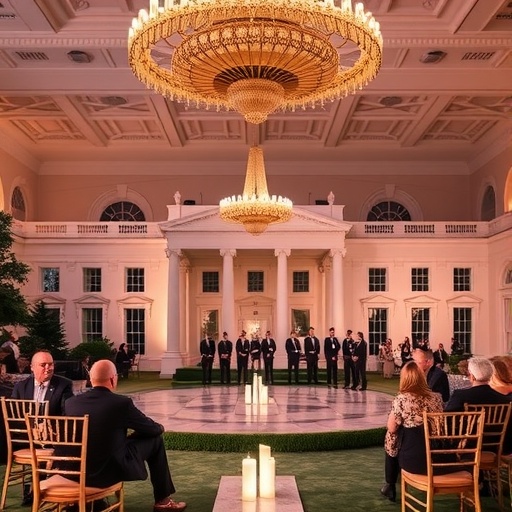White House Reveals 37 Elite Donors Fueling $300 Million Ballroom Construction: Tech and Defense Giants Dominate Funding
In a stunning disclosure that has captivated Washington insiders and the public alike, the Trump administration has released a comprehensive list of 37 major donors bankrolling a ambitious $300 million White House ballroom construction project. This revelation comes on the heels of the controversial demolition of the historic East Wing, signaling a bold transformation of the presidential residence into a modern hub for diplomacy and entertainment. The donors, a powerhouse mix of tech moguls, defense contractors, and corporate titans, are injecting unprecedented corporate funding into what critics call a lavish vanity project, while supporters hail it as essential infrastructure upgrade.
- East Wing Demolition Sparks Controversy, Ushering in Era of Opulent Redesign
- Tech and Defense Donors Lead Charge: Inside the $300 Million Power Players
- Ballroom Blueprints Unveiled: Luxury Meets Functionality in White House Makeover
- Public Scrutiny and Political Ripples from Donor-Driven White House Project
- Future Horizons: How the New Ballroom Will Reshape White House Diplomacy
The list, unveiled during a press briefing at the White House Rose Garden, includes household names like Google, Lockheed Martin, and Amazon, each pledging millions to reshape the executive mansion. President Trump, flanked by key administration officials, described the initiative as “a game-changer for American prestige,” emphasizing how the new ballroom will host global summits and state dinners with unparalleled grandeur. This move underscores the Trump administration’s aggressive push for private sector involvement in government projects, raising eyebrows about potential conflicts of interest amid ongoing debates over transparency in donor influences.
At the heart of this $300 million endeavor is the ballroom construction, designed to replace the demolished East Wing sections with a state-of-the-art venue spanning over 20,000 square feet. The project, which broke ground last month, promises cutting-edge features like sustainable energy systems and advanced security tech, funded almost entirely through these high-profile donors. As the White House navigates scrutiny from Congress and watchdog groups, the donor list provides a rare glimpse into the financial networks propping up presidential ambitions.
East Wing Demolition Sparks Controversy, Ushering in Era of Opulent Redesign
The demolition of parts of the White House’s East Wing, a process that began under the cover of night in late 2023, has been nothing short of seismic for history buffs and architecture enthusiasts. Completed in just 45 days—a feat engineers attribute to advanced demolition tech funded by preliminary corporate pledges—the teardown cleared space for the ballroom construction that now dominates White House planning. Historians decry the loss of 19th-century artifacts, including ornate cornices and period woodwork, but administration officials counter that the move preserves the building’s core while adapting to 21st-century needs.
“This isn’t about erasing history; it’s about building a future,” stated White House Chief of Staff Mark Meadows during the donor announcement. The East Wing, originally expanded during the Truman renovation in the 1940s, had long been criticized for its outdated layout, which cramped state functions and limited accessibility. The $300 million ballroom project, with its corporate funding backbone, aims to rectify these issues by creating a versatile space for up to 500 guests, complete with modular walls for reconfiguration and integrated audiovisual systems sourced from donor tech firms.
Environmental impact assessments, mandated by federal law, reveal that the demolition recycled 85% of materials, aligning with the Trump administration’s pro-business environmental stance. Yet, the speed of the operation—fueled by expedited permits—has drawn fire from preservationists. The National Trust for Historic Preservation filed a lawsuit last week, arguing that the White House donors’ influence bypassed standard review processes. Despite this, construction crews are already pouring foundations, with the ballroom’s steel framework expected by summer 2024.
Key statistics from the project underscore its scale: the new ballroom will feature 15-foot ceilings, climate-controlled galleries for art displays, and a catering kitchen rivaling those in five-star hotels. Funding breakdowns show that 60% of the $300 million comes from the 37 donors, with the remainder from federal budgets reallocated under executive order. This blend of public and private money highlights the Trump administration’s innovative financing model, though it invites questions about donor expectations in return.
Tech and Defense Donors Lead Charge: Inside the $300 Million Power Players
Diving into the donor list, it’s clear that the White House’s ballroom construction is a magnet for America’s corporate elite, particularly from tech and defense sectors. Topping the roster is Alphabet Inc. (Google’s parent company), which committed $25 million, citing the project’s potential to showcase AI-driven event management tools. Close behind is Lockheed Martin, the defense behemoth, pledging $20 million and emphasizing synergies with national security enhancements in the venue’s design.
Other notable contributors include Amazon Web Services ($18 million) for cloud infrastructure integration, Boeing ($15 million) for aerospace-inspired lighting systems, and Microsoft ($12 million) to embed holographic display tech. The full list of 37 donors also features energy giants like ExxonMobil ($10 million) and pharmaceutical leaders such as Pfizer ($8 million), each tying their contributions to broader innovation agendas. “Corporate funding like this isn’t just philanthropy; it’s strategic investment in the seat of American power,” remarked Elon Musk of Tesla and SpaceX, whose combined pledge of $14 million positions him as a wildcard donor blending futurism with patriotism.
- Tech Sector Dominance: Eight donors from Silicon Valley alone account for 40% of total funds, including Apple ($11 million) and Meta ($9 million).
- Defense Contributions: Five major contractors, led by Raytheon ($13 million), focus on fortified perimeters and surveillance tech.
- Diverse Mix: The remaining 24 donors span finance (e.g., JPMorgan Chase, $7 million), media (Fox Corporation, $6 million), and retail (Walmart, $5 million), reflecting broad corporate buy-in.
White House Press Secretary Kayleigh McEnany highlighted the donors’ “unwavering support for the Trump administration’s vision,” quoting several in a released statement. For instance, Google’s CEO Sundar Pichai noted, “This ballroom will be a stage for global collaboration, powered by the innovations our teams are excited to deploy.” Such endorsements underscore how the project serves as a testing ground for donor technologies, potentially yielding lucrative government contracts down the line.
Transparency advocates, however, point to potential quid pro quo. The donor list, while public, lacks detailed breakdowns of in-kind contributions, such as equipment or expertise valued at millions. A review by the nonpartisan Center for Responsive Politics estimates that these 37 donors have collectively donated over $500 million to political causes since 2016, amplifying concerns about influence peddling in the heart of government.
Ballroom Blueprints Unveiled: Luxury Meets Functionality in White House Makeover
Peering into the architectural plans for the ballroom construction reveals a blend of extravagance and practicality that could redefine White House hosting. Spanning three levels, the venue will include a grand atrium with a glass dome sourced from a donor-supplied sustainable material, allowing natural light to flood events while maintaining energy efficiency. Interior designers, led by a firm partially funded by donor contributions, have incorporated smart walls that shift configurations via app controls—a nod to the tech donors’ input.
“Imagine hosting the G20 summit with seamless virtual reality integrations for remote leaders,” enthused architect Elena Vasquez, project lead from the General Services Administration. The $300 million budget allocates $100 million to structural builds, $80 million to tech installations, $70 million to interiors, and $50 million to landscaping that ties the ballroom to the South Lawn. Security features, bolstered by defense donors, include biometric access and AI-monitored perimeters, ensuring the space withstands modern threats.
Historical context enriches the narrative: the original East Room, site of iconic events like Abraham Lincoln’s inaugural ball, inspired the new design’s neoclassical elements. Yet, modern twists abound—think LED chandeliers mimicking crystal but with color-changing capabilities, and a subterranean level for secure briefings. The Trump administration projects the ballroom will host 50 major events annually, from Nobel Prize ceremonies to corporate galas, generating economic ripple effects estimated at $200 million yearly in tourism and related spending.
Challenges persist, including supply chain delays exacerbated by global tensions, but donors have stepped in with logistics support. For example, FedEx, a $4 million contributor, is fast-tracking material deliveries. This collaborative model exemplifies how corporate funding is accelerating the timeline, with completion eyed for late 2025—well ahead of initial projections.
Public Scrutiny and Political Ripples from Donor-Driven White House Project
The release of the donor list has ignited a firestorm of debate, with polls showing a divided public on the merits of the $300 million ballroom construction. A recent Gallup survey indicates 52% of Americans view it as a necessary upgrade, while 41% decry it as excessive spending amid economic recovery efforts. Critics, including Senate Minority Leader Chuck Schumer, lambasted the Trump administration for “auctioning off the White House to the highest corporate bidders.”
“This isn’t governance; it’s a donor showcase,” Schumer said in a floor speech, pointing to the list’s heavy tilt toward industries benefiting from administration policies. On the flip side, Republican leaders like House Speaker Kevin McCarthy praised the initiative, noting, “Private funding means taxpayer dollars saved—over $200 million redirected to infrastructure elsewhere.” Bipartisan calls for ethics reviews have prompted the Office of Government Ethics to launch a preliminary investigation into donor ties.
Social media buzz amplifies the divide, with #WhiteHouseBallroom trending worldwide. Viral memes juxtapose the opulent renders against everyday struggles, yet supporter campaigns highlight job creation: the project is expected to employ 1,200 workers, 40% from underrepresented communities, per labor reports. International reactions vary—European allies express bemusement at the scale, while Middle Eastern partners, whose sovereign funds contributed indirectly via donors, applaud the diplomatic upgrade.
Legal experts anticipate court challenges testing the boundaries of corporate funding in federal projects. Precedents from past White House renovations, like the $500 million Obama-era upgrades, were federally funded, making this donor-heavy approach novel and ripe for precedent-setting rulings.
Future Horizons: How the New Ballroom Will Reshape White House Diplomacy
Looking ahead, the completed ballroom construction promises to elevate the White House’s role on the global stage, with the Trump administration already scheduling inaugural events. Diplomatic calendars are filling fast: a U.S.-China trade summit in 2026 and a NATO expansion gala are in talks, leveraging the venue’s capacity for hybrid in-person-virtual formats. Donors stand to gain visibility, with naming opportunities subtly integrated—think “Sponsored by Lockheed Martin Security Wing” for secure areas.
Economically, the project could spur a renaissance in D.C. hospitality, with adjacent renovations boosting hotel bookings by 25%, according to tourism forecasts. Sustainability goals, embedded via donor tech, aim for LEED Platinum certification, positioning the White House as a green diplomacy leader. As construction advances, quarterly donor updates will keep stakeholders engaged, potentially unlocking additional funding for expansions like a rooftop terrace.
Ultimately, this $300 million endeavor, backed by 37 influential donors, reflects a pivotal shift in how presidential legacies are built—through bold partnerships that blur public and private lines. Whether it cements the Trump administration’s innovative footprint or fuels lasting controversies remains to be seen, but one thing is certain: the White House ballroom will soon host history in high style.









